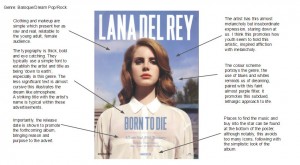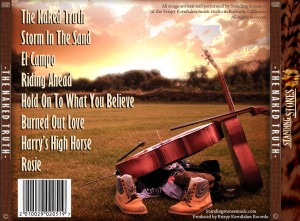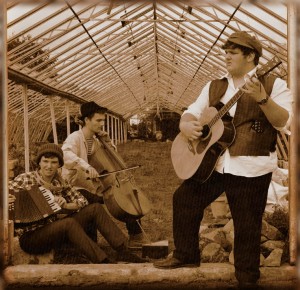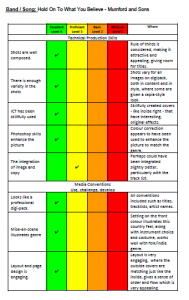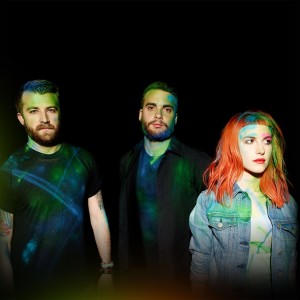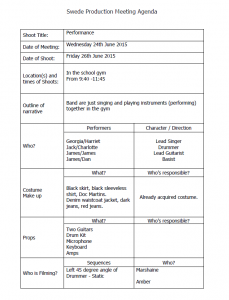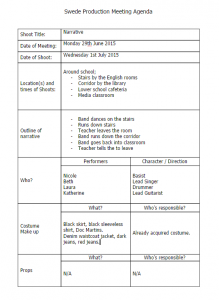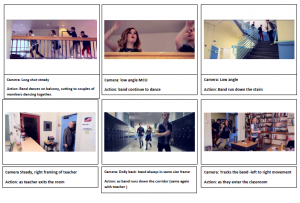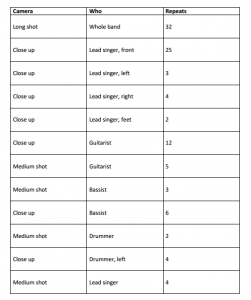Before creating our own advertisement, we looked at the conventions of one. Below you can view my analysis of Lana Del Ray’s ‘Born To Die’ advert. It was really useful to consider what was included within an advert such as; album names, artist names and release dates, are all conventional features we plan to include.
Research
Previous Students Work – Digipak
To understand the assessment criteria for the digi-paks, I’ve looked at a previous students work, to understand how they were successful.
You can see below the digi-pak;
I then compared various aspects of the assessment criteria with this digi-pak, you can view this below by clicking the image below. You can clearly see how successful this digipack was, it was constructed professionally and presented in a way that is really appealing and engaging.
Digipak Conventions
Swede Evaluation
What lessons did you learn about planning and the use of Storyboards/Shot Lists and Production Meeting Agendas? Why are they important when out on shoot?
Having created storyboards in groups, it made the shoot so much easier. We had planned every shot within the music video so we knew there would be time missing clips. Creating a shot list was so useful, because it basically cut down the amount of shots, as in, the final video would include the same shots but we will just cut between them. So really, we mainly had these basic shots to film. The project meeting agenda was also really useful because it meant that we knew exactly who was bringing in costume, props and the equipment for filming. Therefore when it came to the filming day we were able to film without a problem.
TARGET:
Next time I will try and create a more detailed storyboard, and really think about how I want the edit before so I have the shots I need.
What should the camera operator be doing whilst filming?
The camera operator should be keeping a close eye on the performers and actors. If need be they should move the camera, especially for close ups panning round a little bit may be necessary. It is their job to follow the action.
TARGET:
Watch the camera carefully to be sure the action is within the shot.
What lessons did you learn about directing people in front of the camera? What information do they need to know about their character / their performance style? How can the director get them to relax and have confidence in front of the camera in order to perform well?
When directing people its so import to make sure they feel comfortable. We were able to do this by creating an atmosphere that fitted the music, and dancing behind the cameras! The actors were then able to act without embarrassment and so gave us a really great performance. It was important to know what kind of character we wanted them to play, so we could actually tell them how to act. As a director, you just need to be, well, direct and confident with your visions!
TARGET:
To be more assertive and direct with the performers.
What lessons did you learn about filming the performance for your production?
When filming the performance, it is vital that we film the entire performance for all the different shots. This will ensure everything can be synced easily and to fill in any spare time we may have.
TARGET:
When we filmed the performance we left a tripod in the shot, and had to re-film that take, so when I film my own I should really watch out for any camera equipment or generally unwanted items.
What did you learn about editing and post-production?
When editing the music video, you should really sync all of the performance clips to the audio first. This makes it really easy to cut between the footage later on. Additionally, with music videos, something really important is editing to the beat of the song, this makes it much more appealing and fitting to the song.
TARGET:
To really consider the editing even before filming, to ensure I get the right shots and then edit to the beat to create a really appealing video.
What did you discover about the use of conventional Mise-En-Scene for music videos?
Conventional mise-en-scene helps to reflect the genre of the music, and really set the tone and feel of the video. This can be really important because otherwise the video won’t fit the song properly, and may end up looking awkward.
TARGET:
To not clutter the frame, be have simple and significant mise-en-scene, which will be much more affect and visually pleasing.
The Swede
After all the groups had finished editing their section of the swede, they were all edited together to create our finish version of ‘Come Together’. A lot of it was very similar to the original but it did come apparent some parts didn’t get filmed so we had to fill in the time with another clip. Below you can watch the final swede;
My Section of the Swede
Once we had filmed the swede, me and my partner were given the opening seqeunce (0.00-0.42) to edit together. This mainly consisted of narrative with some performance too. Together we used premiere pro to import the footage, and learnt how to sync the audio, Come Together, with our video. We synced all of the performance shots so that it would be easy to cut between them when it came to matching it with the original video. We then added in all of the narrative footage and simply matched it to the music video! Below you can see the opening sequence to the swede we edited;
Project Meeting Agenda – Performance
Project Meeting Agenda – Narrative
Before we went out filming, our group talked about our section of the narrative. We had created a storyboard, but we needed to make sure we had the right costumes, props and knew where we would be filming to make sure everything went as smoothly as possible. We created a project meeting agenda to consider these thoughts, which you can view below by clicking the image;
Narrative Reverse Storyboard
In groups we got assigned part of the narrative to film. Before we could start doing this, we had to create a storyboard, using the actual music video to see exactly what kind of shots we needed to do. Below you can see the storyboard we created;
This really helped when it came to filming, as we could see the exact framing, composition and movement we needed and wanted in each of the shots, thus making the filming time much more efficient and it became much easier to direct our actors.
